MENUMENU
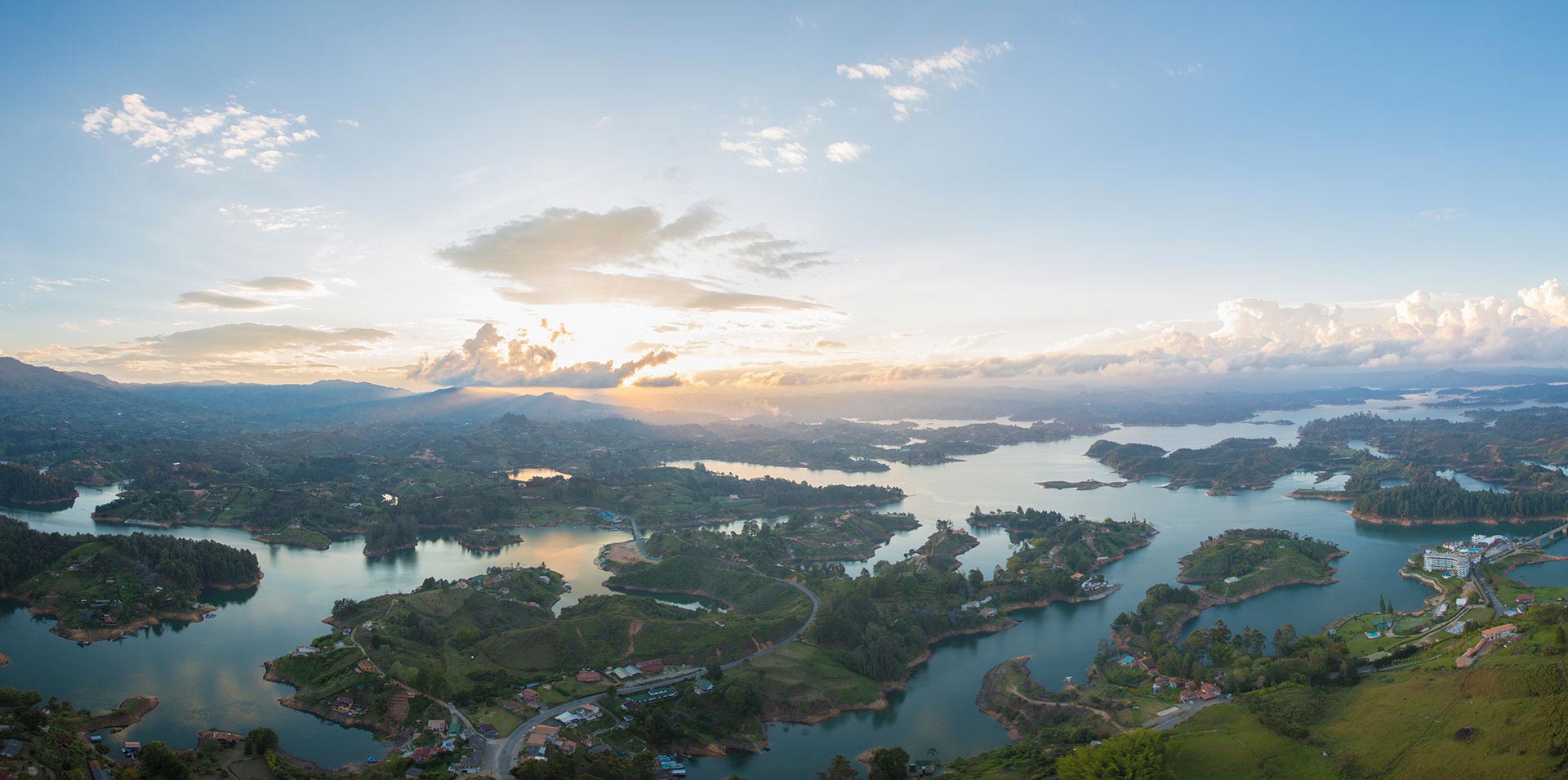
Reading time: 28 mins
Traveling to Colombia will take you to classic historical sites; it is a country that has, throughout recent years, earned its status as being a wholly diverse paradise and one of the best countries to visit in South America. Bathed by its precious Pacific and Caribbean waters, this country galvanizes the imposing beauty of the Andes Mountain Range, the Amazon, and its countryside with the warm smiles of its inhabitants. Despite its tumultuous and notorious history, the country has managed to shed its past and earn its place as one of the top destinations to visit while in South America. Now, Colombia is just as safe to see as the grand majority of countries in the world, and, as the country’s slogan goes, “the only risk is wanting to stay.” What’s more? Due to its geographical location, Colombia holds the title for having one of the highest levels of diversity of flora and fauna in the world.
If you’re looking to visit Colombia but need to figure out what you’ll need to know about traveling there (and moving about within the country), this blog is here to help you resolve precisely that!
On the other hand, if you are still trying to figure out why you should travel shortly, here is a blog that will put your mind at ease. Click on the link below and keep on dreaming. Adventure and life are just around the corner… in South America!
Most visitors do not need to apply for a visa to visit Colombia beforehand. The U.S., Canada*, Western Europe, and select countries in Asia and Middle Eastern countries are exempt from requiring a visa upon arrival. Citizens from these countries and regions will automatically receive a tourist visa upon entering the country. This visa allows tourists to stay in Colombia for up to 90 days. Additionally, it is highly recommended that visitors also have their return ticket handy, as immigration officials may request this upon entry.
If you’re a citizen not from one of the aforementioned countries or regions above, it’s best to check if you’ll need one!
*Canadian citizens are required to pay a “reciprocity fee” for entering Colombia is $160,000 Colombian pesos (approximately $68 Canadian dollars).
Citizens from Bolivia, Ecuador, and Peru can easily travel with their passports, as they can readily enter with a valid photo ID from their respective countries. Otherwise, you’ll be required to show your passport at your Colombian point of entry.
Important: Remember that your passport must still be valid for at least six months after your return date from Colombia.
Tip for travelers: While traveling through any country, Metrojourneys always recommends keeping color copies of your important identification documents (passport or official ID) at all times and leaving all original documents back at your hotel in a safe deposit box.
Spanish is the dominant language of Colombia, with over 99% of the population using it to go about their daily lives. Nevertheless, in certain major cities, you may find Colombians who speak English with varying degrees of fluency. If the Spanish language might present a potential barrier for you as a visitor, it is recommended that you book through a Travel Agency. Doing so will give you the benefit of having a bilingual guide accompany you around and resolve any language barriers that might arise throughout your journey in Colombia. What’s more? A reputable Travel Agency will also include accommodation options, transfers, meals, and first-class tours through this gorgeous destination, meaning you won’t have to lift a finger when planning the potentially tricky logistics of your journey.
Colombia Fun Fact: The remaining less than 1% of languages in Colombia consist of 65 different Amerindian languages, 2 creole languages, and the romani language.
The peso is the official currency of Colombia, so get ready to change your money! No other cash is accepted in Colombia; don’t let that “$” symbol fool you! Colombia uses the same symbol as the US does to designate its currency. Nowadays, the exchange rate is around $1 US dollar = $4897.50 Colombian pesos (€1 Euro = approx. $5235.88 Colombian pesos).
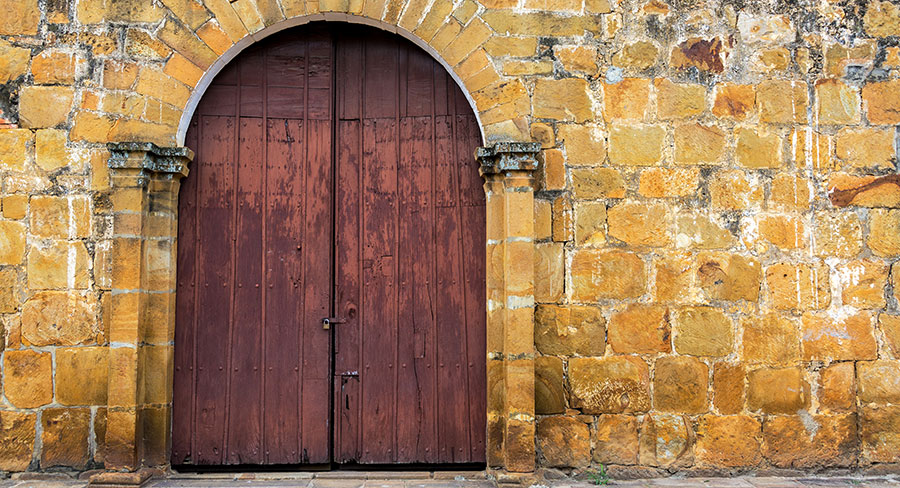
Colonial door in Colombia
As you’ve probably already noticed by the exchange rate, banknote denominations in Colombia are usually seen in the thousands, with the highest banknote denomination being $100,000. This may very well mean that, depending on how much you’re carrying with you, Colombia could be where you get to be a millionaire!
Tip for travelers: We recommend exchanging your money upon arriving at the airport, as the rate offered there is often better than what’s offered outside or in the city.
Credit and debit cards (Visa, American Express, and MasterCard, among others) are accepted throughout Colombia. It’s worth noting, however, that you’ll likely only be able to use these at major commercial establishments, such as shopping centers, restaurants, and/or hotels. Otherwise, if you’re looking to buy items from artisanal markets, pay for a local taxi, or eat at a small, typical restaurant, you’ll want to keep cash on you.
What time zone is Colombia in?
Colombia’s time zone is GMT-5, meaning that if it’s 10 a.m. in Colombia, then:
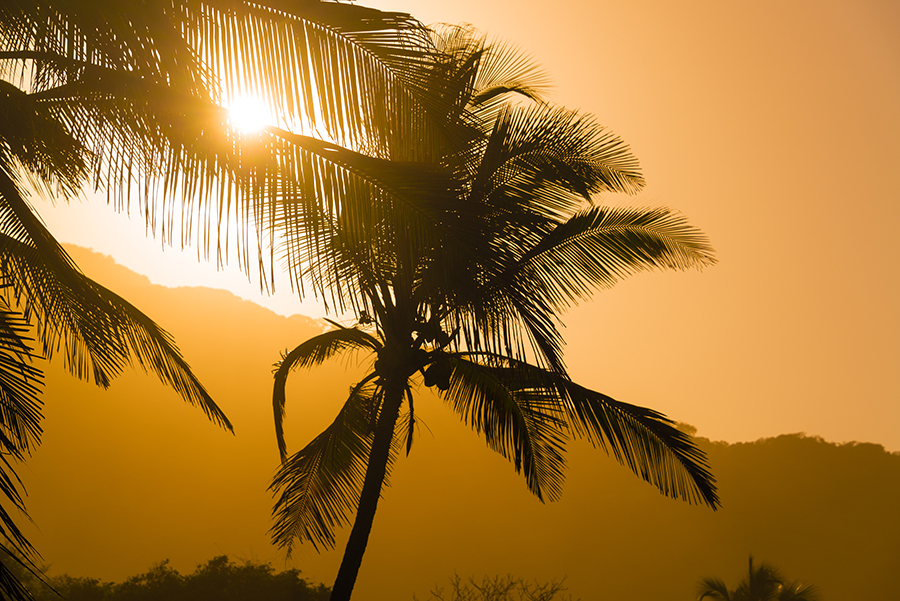
A beautiful sunset over Colombia
In determining when is the best time to travel to Colombia, one of the first considerations to note is weather and climate. This being the case, you’re in luck! Thanks to its geographical location and incredible topography, Colombia’s climate is generally attractive all year round. The coastal areas are typically hot and humid. Moving inland a bit, the lower valleys and forest regions take on a slightly more comfortable yet still warm and very comfortable climate. This region also tends to experience a healthy amount of rainfall and, during certain times of the year, are more consistent.
Meanwhile, areas like the capital, Bogota, situated in much more elevated regions of the country, see very comfortable yet slightly cooler weather patterns throughout the year.
Popular coastal destinations like Cartagena, along with nearby Barranquilla and Santa Marta, occupy the northern tip of Colombia and about the Caribbean Sea. These locations, however, still vary in climate, mainly due to rainfall. Cartagena, for instance, sees very little rain from December through April, but quite a bit of rain, up to 7.5 in (191 mm), in October. Temperatures here are incredibly consistent throughout the year, ranging between about 72°F and 89°F (22°C – 32°C) year-round. In contrast, Santa Marta consistently sees more rain throughout the year, with only a few months that feel considerably drier (mainly July and August). Temperatures are a little more dynamic, ranging between 70°F and 94°F (about 21°C to 34°C) on average.
For inland cities, such as that of Medellín, climate-wise, one of the most significant advantages is the incredibly temperate weather. Warmer than Bogota, residents of Medellin and visitors to the region can enjoy temperatures that typically range between 62°F and 78°F (16°C and 26°C). One downside is that the skies tend to be more overcast than normal. Regardless, the climate in this region lends itself to exploring numerous parks and plazas found throughout each city.
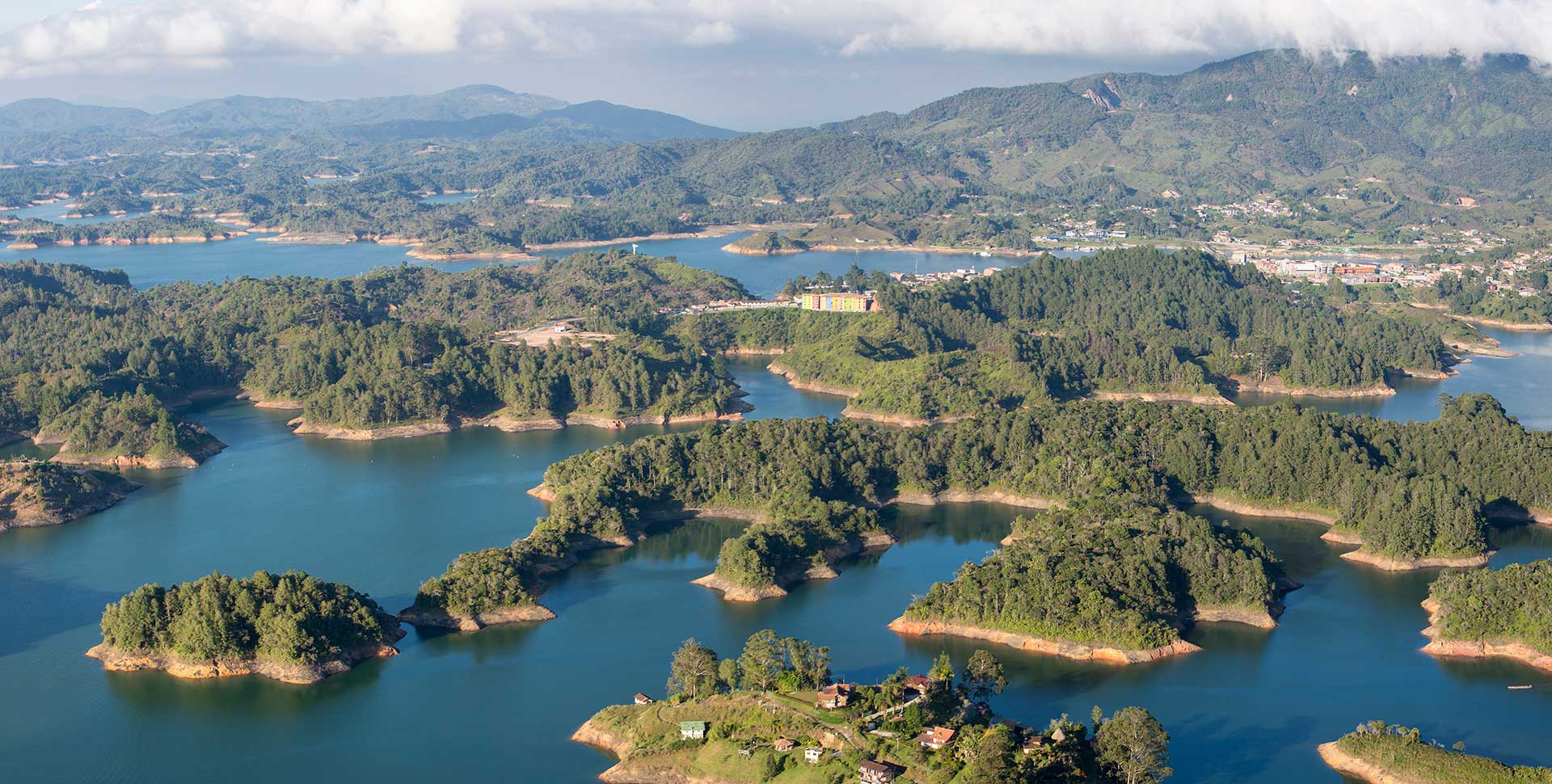
Islands and Lake in Guatape, Colombia
One of the main reasons why the Coffee Triangle is so ideal for coffee production is that the climate here is generally perfect. The warm weather, the welcome and frequent patches of rain, the marvelous sunshine, and the sloping topography all combine to create some of the best conditions for coffee cultivation worldwide. These factors are also why this is becoming an increasingly popular touristic region.
The rainfall is dynamic throughout the year, creating two separate harvest seasons. The heaviest periods of rain are April into May and October into November. The rest of the months tend to see moderately less rain. The temperatures year-round don’t often drop below 60 °F (about 16 °C), nor do they typically climb above 82 °F (about 28 °C).
The two distinct periods of heavier rainfall that we see in the Coffee Triangle region (April into May and October into November) are also typical for Bogota, despite its much higher elevation: 8,000 ft (2630 m) above sea level. The climate in the nation’s capital is quite moderate, though slightly cooler than in the rest of the country. If you’re a fan of dressing in a couple of layers, this is the perfect city! Temperatures average between 46°F and 68°F (8°C and 20°C), with the cooler months being December through February.
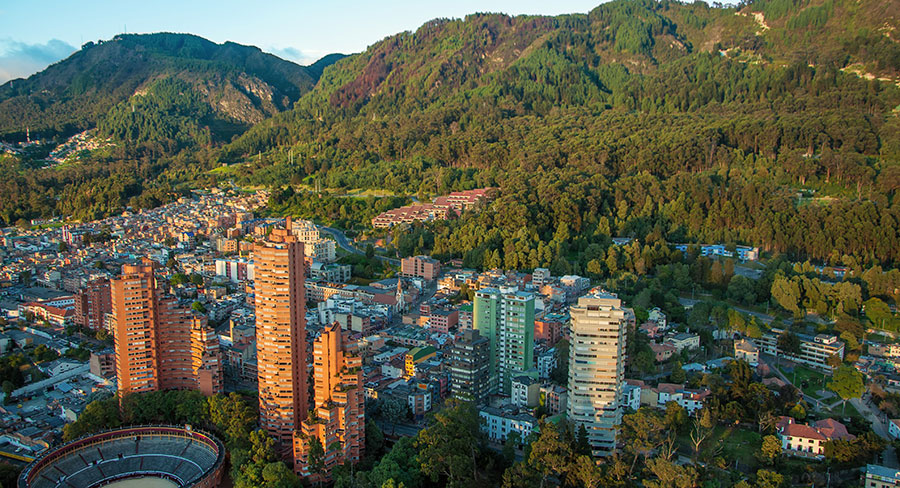
City of Bogota with the Andes Mountains in the background
The remarkable nature on display in the Orinoquia region, home to Caño Cristales (Crystal Channel), sees an incredibly dynamic climate that varies throughout the year. The months of January, February, and March are significantly warmer when temperatures range between 72 °F and 96 °F (21 °C and 35 °C). The rest of the year sees temperatures that, though still warm, range between 73 °F and 90 °F (22 °C and 32 °C). Incidentally, this tends to cover the most colorful period on display at the Crystal Channel (late June through November). And, though rain tends to be more frequent between April and August, the rest of the year enjoys a charming, humid climate. Any time of year is perfect for visiting this fascinating region!
These things are worth considering when planning your visit to the country. Additionally, no matter which regions you visit, chances are you will come across some local festivities, celebrations, and events that will enhance your experience of Colombia. In general, national and religious holidays are scattered throughout the year; however, the country is proud of its heritage and customs, and this is reflected in the pageantry, dress, and cuisine waiting to be experienced through locally-based celebrations of music, art, and performance, which, fortunately, are both frequent and varied. Enjoy an amazing trip to this beautiful country on our Colombia vacation package.
The standard voltage in Colombia is 110 volts, with a frequency of 60 hertz, the same as that used in the US.
Two kinds of electrical outlets are used in Colombia: Type A and Type B.
Type A plugs are those that are typically seen in the US and Canada, which consist of two flat prongs that are parallel. Type B is the same as Type A, except that these have an extra, rounded prong for grounding. Type A plugs work with either Type A or B outlets, while Type B plugs only work with Type B outlets. If you’re planning on visiting Colombia and residing in a country that doesn’t use either, it’s recommended that you bring an electrical outlet adaptor.
Proof of having received specific vaccinations is not required to enter Colombia. Nevertheless, normal precautionary measures should be taken, and it’s best to check with your country’s embassy, disease control and prevention center, and/or consulate to see what vaccinations they recommend for traveling to Colombia.
Proof of health insurance is not required to enter Colombia. However, we strongly recommend having it in the rare event that an unfortunate incident occurs during your travels, as it always helps to have that peace of mind when traveling in a country far from home. And while we’re on the subject of unfortunate incidents…
While potable, it’s recommended that visitors refrain from drinking tap water in Colombia. Often, it isn’t as filtered as other parts of the world, which may lead to an upset stomach. Instead, it’s best to stick to bottled, mineral, or filtered water that you can readily find throughout the major cities.
Traveling by bus in Colombia is a relatively cheap way of getting around, albeit time-consuming. Journeys from Bogota to iconic destinations, such as Cartagena, can take approximately 23 hours to complete! Such long-distance trips typically will cost at most $50 one-way.
Another highly time-efficient way of getting around Colombia is by air, with numerous airlines offering domestic flights to several popular cities. For example, a trip from Bogota to Cartagena by air takes just 1 hour and 30 minutes and can often be found at prices that are just a little over $50, one-way.
Ultimately, the choice will depend on just how much time you have in Colombia and whether you’re willing to cut some corners out of said time to save a relatively modest sum. Given that it’s easier to acquire airline tickets online, and because most bus companies don’t offer this option (and might sometimes even be sold out upon getting to the counter), we recommend traveling from city to city by air.
Tip for travelers: If you already know that your timeframe within Colombia is somewhat limited and that you’d rather avoid getting caught up in the logistical intricacies of planning your trip from scratch, then it’s highly recommended that you book your trip through a reputable Travel Agency! These will often deal with all of these steps for you; and even organize your accommodation, transfers, tours, and meals throughout your trip. If this catches your interest, the only thing you need to do is have a look at the tour packages that are available in Colombia. Speaking of which, why not take a gander at ours?
The best way to get around within cities in Colombia is undoubted via taxi. These are abundant in number and quite economical in price. It’s also impossible to mistake them for any other type of vehicle, as registered taxis are all bright yellow. Taxis in Colombia operate using taximeters, with few exceptions. In Cali and Medellin, clients are expected to pay the price reflected on the meter. In Bogota, however, a slightly different system is used: the cost of your journey is calculated by zones or bands, and the taximeter displays what band your ride falls into at the end of your trip. To know how much each band costs, clients need only consult the chart (usually a laminated sheet of paper) that is always found hanging off the backside of the driver’s headrest.
Regarding taxis in Colombia, Cartagena is one of the few cities that break from the standard mold. Here, instead of relying on a taximeter to figure out the price of your trip, you’ll need to negotiate costs with the driver before you even get inside the cab.
Tipping taxis in Colombia is optional or expected. However, you can pay for your ride in cash.
Other alternatives to taxis in Colombia include using popular Apps such as Uber or Cabify. These Apps, as readers of this blog, may already know, allow users to request a taxi through their smartphone and establish their pick-up and drop-off points. Often, ordering a taxi through these kinds of apps enables the user to see the estimated journey cost before ordering their cab!
Despite its grim past consisting of guerilla warfare and drug barons, Colombia has, over the course of the past two decades, managed to completely shed that dark and tired, old skin to become one of the safest destinations to travel to in Latin America. The difference between what it once was versus what it is now is day and night – visitors are warmly welcomed to the country and virtually never have to worry about being kidnapped, mugged, or worse.
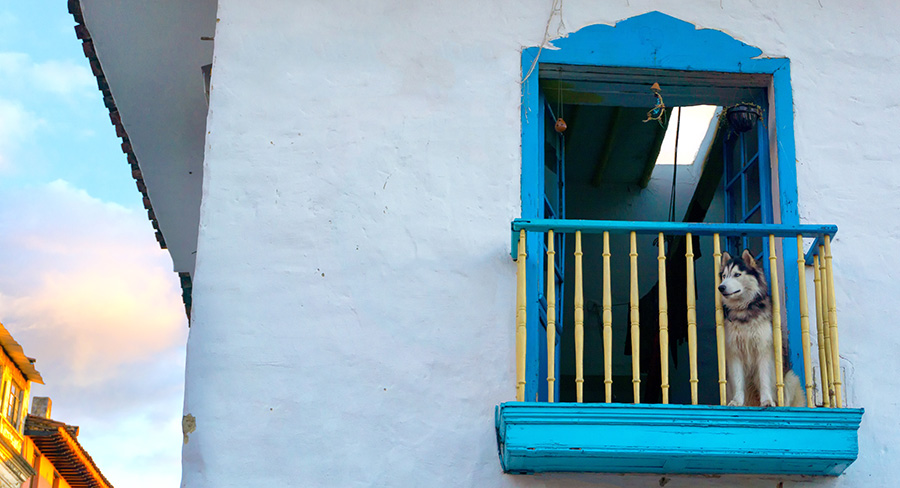
Colonial balcony in Bogota, Colombia
It’s still worth reminding our readers that Colombian cities require a certain level of prudence and awareness, just like any other major city in the world. Common sense should be preserved, and it’s always best to stay within the main parts of town or in shady neighborhoods. The same applies to regions or areas of Colombia that are off the beaten path (particularly the border along Venezuela), which, for the most part, we advise going with proper research or asking the locals about their thoughts on those places first.
Note: Recently, mass immigration from Venezuela has raised concerns concerning Colombia’s safety, but such circumstances are only focused on the border between Colombia and Venezuela. Major tourist destinations in Colombia usually operate and are free of such troubles.
It’s always a great idea to research and plan before embarking on your trip to Colombia. Many people align themselves with what’s commonly known as “the gringo trail.” This trail covers some of the most famous cities in the country, connecting to each one in a rather convenient way thanks to numerous air and bus transit options. However, such a “play it by ear” trip might not be the best option for those with a limited timeframe.
By planning your trip with a Travel Agency, on the other hand, you’ll be able to optimize your time as a whole and enjoy each place properly without ever feeling too rushed or concerned about logistical factors.
Colombia offers a wide array of different vacationing styles for all those that wish to satisfy their interests and desires while traveling through this magnificent country. Principally, however, visitors tend to come to Colombia to soak in the rich history and the colorful culture it is home to.
Several indigenous groups, including the Muisca, Tayrona, and Quimbaya, originally populated Colombia. However, these indigenous populations decreased substantially in number after being invaded and conquered by Spain. The Spanish conquest brought European settlers that ultimately assimilated these indigenous tribes into their colonies and bloodline, leading to a mix of Spanish and indigenous ancestry.
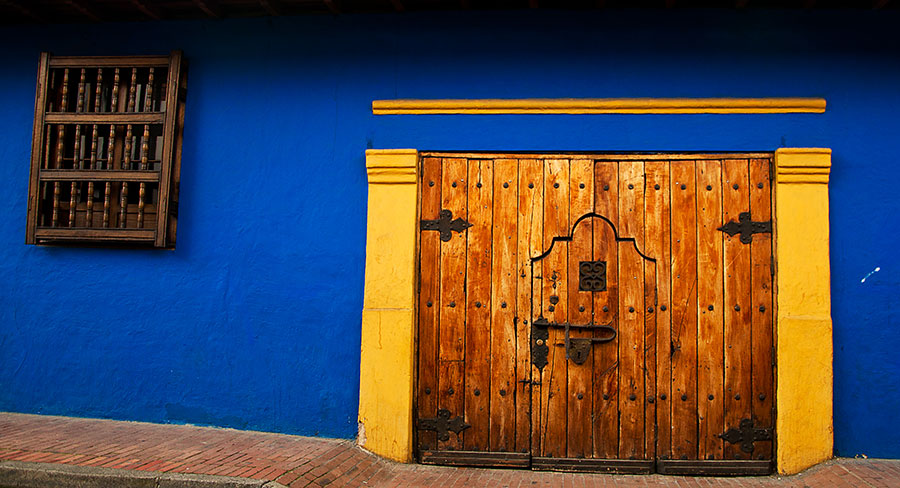
Blue wall and colonial style doors in Bogota “La Candelaria” neighborhood, Colombia
While Colombia gained its independence from Spain in 1819, several enormous facets of the Spanish empire’s presence remain to this day. These can be seen in the numerous forts, castles, and architectural styles still present at various visitor sites, the most significant and most notable of which are found in the coastal city of Cartagena.
Wherever you go in Colombia, its people exude a sense of pride, energy, and charisma that’s hard to compare to anything else. That’s why a trip to Colombia would only be complete with adequately engaging with the culture and traditions it is home to. Visitors, for instance, can have humbling encounters with Colombian farmers that have worked the rich, fertile lands to grow some of the best coffee in the world over in Pereira. You can also encounter the proud and charming palenqueras that enliven Cartagena’s streets with dazzling and colorful traditional dresses and bowls of fruits that they carry atop their heads. Medellin also holds its fair share of flower cultivators that impress with their flower farms and arrangements. Wherever you go in Colombia, there’s an invigorating story behind each person you meet and a captivating smile to accompany it.
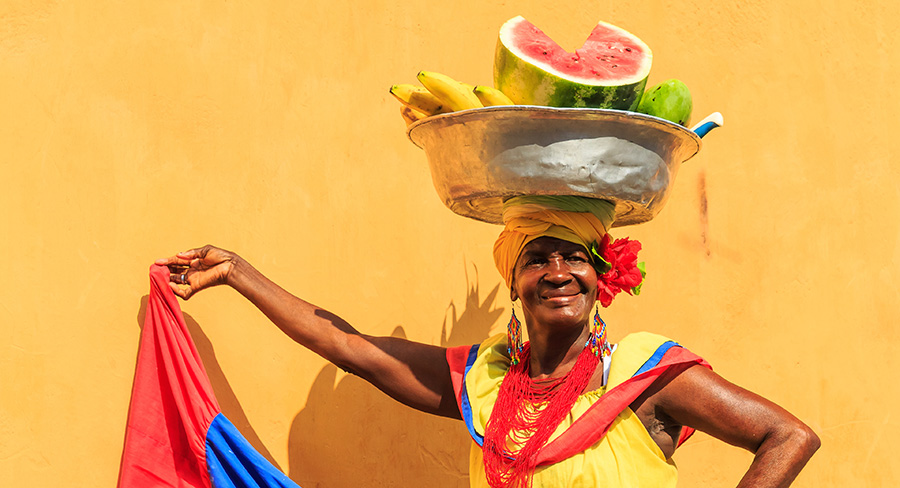
Traditional Palenquera Dress in Cartagena, Colombia
Colombia’s cuisine is significantly influenced by its tremendous biodiversity and cultural traditions. Dishes in the country usually include some form of rice, corn, potatoes, and a variety of meats (chicken, beef, pork, goat, and seafood). The country has an exotic and enticing medley of fruits, which include: granadilla, guava, dragon fruit, and goldenberry, among several others! So definitely feel free to dabble in new and exciting flavors in Colombia!
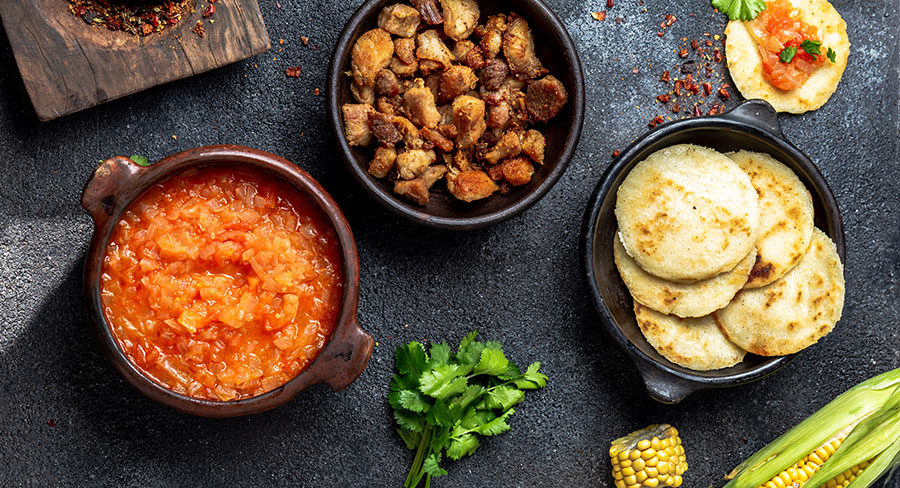
Traditional food in Colombia
Some of the most typical plates you’ll find throughout your travels are arepa (thick corn tortillas), ajiaco (a hearty potato and corn soup with avocado and chicken), and the bandeja paisa (rice, beans, eggs, and plenty of meat).
Tip for travelers: Think twice before buying street food! While alluring, cleanliness standards at these spots sometimes need to be better than that of many other traditional establishments and restaurants.
The capital city of Colombia is home to over 8 million people. Located at around 8,000 ft (2630 m) above sea level, this remarkable metropolitan city is full of history, museums, financial and governmental institutions, elegant neighborhoods, modern shopping centers, first-rate universities, and incredible restaurants. Even more impressive is how this metropolis buzzes with life and excitement. There is almost too much to see and do in Bogotá! Here is just a small sample of some things not to miss.
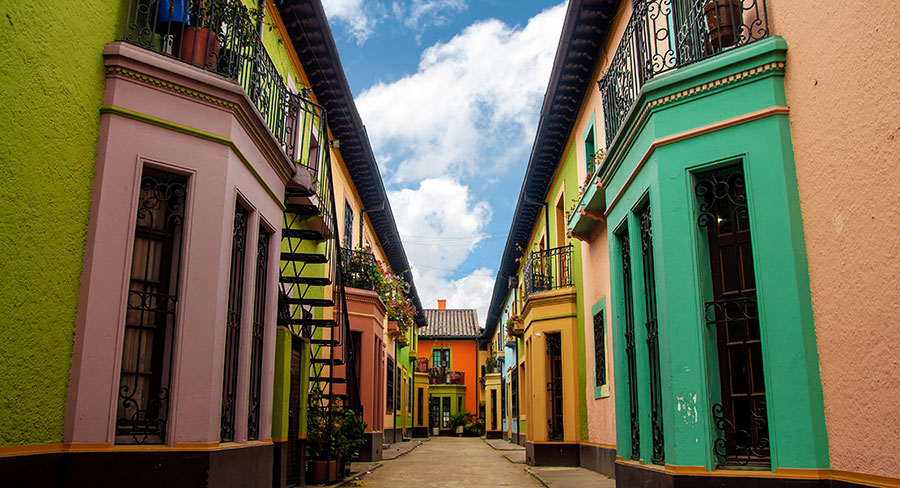
Colorful historic walls in Bogota, Colombia
The Gold Museum (Museo del Oro) is the most well-known museum in the city. Colombia, highly regarded for the quality of gold found here, boasts Incredible artifacts from pre-Colombian times on display in this ultra-sleek and uniquely-lit museum. The Botero Museum pays homage to one of the most important Colombian artists, Fernando Botero. His portrayal of the human body is charmingly curvaceous, and his paintings are wildly popular for the life and humor with which they capture the human experience. The Colombian National Museum is another solid option. This treasure features cultural, historical, and artistic works that significantly contribute to and reflect Colombian identity and experience.
High atop the city, on Monserrate Hill, sits a mystical church dedicated to El Señor Caído (The Fallen Lord). Legend has it that when couples make the trek to this shrine, only those who the Lord approves indeed last; the rest ultimately separate. This doesn’t stop curious visitors from riding the teleférico (cable car) to the top and enjoying the stunning views of the city, no matter the time of day.
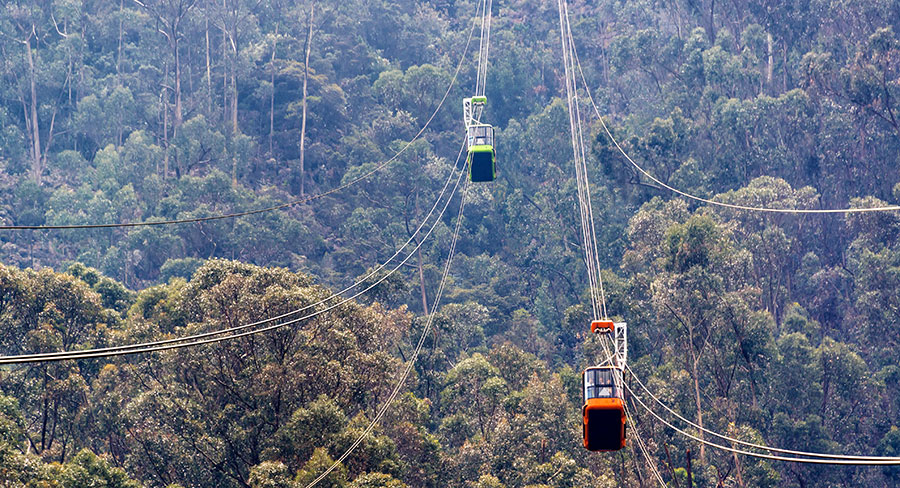
Gondola Lift to Monserrate Hill
Just to the north of Bogotá, about 90 minutes outside the city center, is the astonishing Salt Cathedral of Zipaquirá, a Roman Catholic church built deep inside the salt mines, over 650 ft (200 m) below the ground. This feat of architecture has been referred to as the “Jewel of Modern Architecture” and represents an important cultural and religious patrimony for the Colombian people.
One of the geographical features of Colombia that sets this nation apart from other countries in South America is that it straddles the Caribbean Sea and the Pacific Ocean. This is where Cartagena de Indias comes into fashion. Perhaps the most important port in all of Colombia, Cartagena was founded in 1533, and its extensive history echoes throughout the old town, a walled-in area that includes a fortress and numerous colorful and well-preserved colonial buildings. A favorite spot of many visitors to Colombia, Cartagena offers a rich and festive cultural tradition, visible in its distinctive art, food, and architecture.
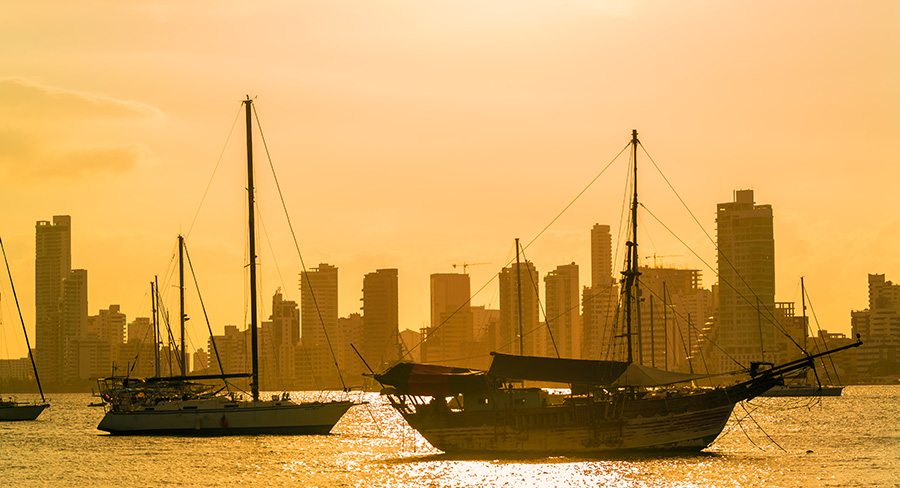
Boats and skyscrapers at sunset in Cartagena, Colombia
Some notable highlights in Cartagena are the Ciudad Amurallada (Walled City), a popular neighborhood among tourists and locals alike and feature Andalusian-style architecture. It is full of cool little shops, restaurants, bars, and hotels and is conveniently located in the city’s center. Another true landmark is one of its numerous fortifications, the impressive Castillo de San Felipe de Barajas (San Felipe de Barajas Castle), which functioned as more of a fortress from its strategic location atop the Hill of San Lázaro. It was one of the earliest colonial fortifications.
The Cartagena Gold Museum, the Teatro Heredia, the famed Clock Tower, and the Bóvedas (or Vaults) are just a handful of interesting sites to visit when touring through Cartagena.
Located about 250 mi (400 km) from Bogotá, the unique and popular city of Medellín is the crown jewel and capital of the Antioquia Department. It is also the second-largest city in Colombia, with over 2.5 million people. Located in one of the more mountainous sections of the department, one of the exemplary features of Medellín is its modern commuter rail system, a network that combines rail, gondola (cable cars), tram, and bus transportation, unites the different neighborhoods located throughout the city, at various altitudes. It also provides residents and visitors a great way to view the city.
Throughout this current century, Medellín has seen an incredible transformation. Municipal leaders have invested heavily in increased security, education, and development. In turn, this has made the city an attractive destination to visitors from all over the world. Many of the city’s numerous and beautiful plazas and parks are designed to be interactive and to inspire outdoor activity and education. Education and ecotourism are at the heart of many of Medellín’s natural viewpoints, situated atop the city’s hills.
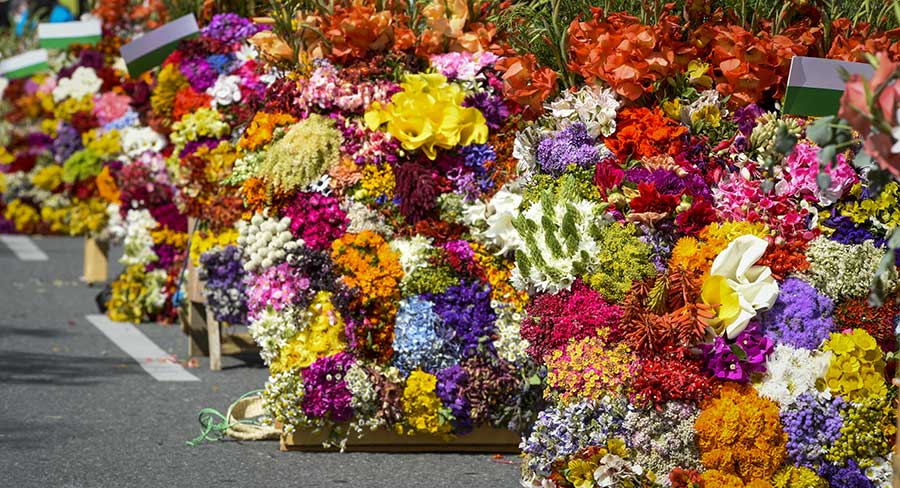
Flower festival in Medellin, Colombia
In the northeast part of Medellín, Ecotourism Park Arví serves as an ecological nature reserve and an important Pre-Hispanic archeological site. A little over one-tenth (about 1,760 ha) of its total size features forests in their natural state. Add to this over 50 miles of walkable trails, convenient public transportation to and from the park, and one of the most important tourist attractions in Medellín.
The city is also fantastic for arts, culture, science, and history, as is the case with exciting places like the Museo del Arte Moderno (Modern Art Museum), Museo de Antioquia (Antioquia Museum), Medellin Planetarium, and Jardines Botánicos (Botanical Gardens of Medellín).
Coffee is one of the most important exports and the most widely loved throughout the planet. Colombian coffee is renowned for its rich flavor, thanks partly to the volcanic soil in this region just west and adjacent to the Andes. The “coffee triangle” (or “coffee axis,” eje cafetero, in Spanish) refers to three different, adjoining departments that comprise this beautiful, often-sloped, humid, and warm cultivation area: Quindio, Risaralda, and Caldas. This region is a UNESCO World Heritage Site. Each department has a beautiful capital city worth visiting. These are Armenia, Manizales, and Pereira -a city with over 700,000 inhabitants, which features monuments like the Bolivar Statue, architectural structures like the César Gaviria Trujillo Viaduct, fancy shopping areas like Circunvalar Avenue, and many swimming areas and parks, not to mention the Botanical Garden of Marseille.
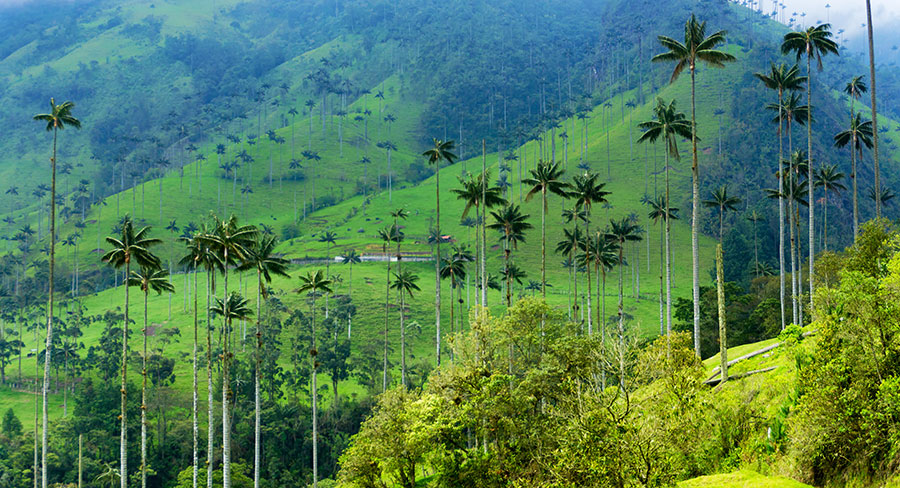
Wax palm trees in Cocora Valley, Colombia
Small towns also play important roles in the coffee production and tourism economy of the region; among these is the charming town of Salento, which features remarkable colonial architecture, colorful neighborhoods, and any number of unique shops and restaurants. A typical lunch here involves smoked trout. A visit to the Coffee Triangle gives visitors to Colombia an important window into the country’s culture, cuisine, nature, and beauty.
Nature is most impressive in the region best known for being home to the Orinoco River, one of the longest in South America and one of the largest (by volume) in the world. Orinoquia’s Eastern Plains, or Llanos Orientales, play host to an area called the Macarena. Here you will find the famous, though not heavily- visited, Caño Cristales. This magical place is notable for the Macarenia clavigera plants, responsible for the rainbow of colors (red, yellow, green, blue, and black) displayed along the riverbed, mainly between the end of June and November. Flora and fauna in this region are equally interesting and attractive. If nature is what you’re looking to explore in Colombia, this destination is a good one to keep in mind.
Colombia’s level and quality of service shine in its authentic way. The very character of Colombians, in general, tends to be charged with friendliness, intuition, and warmth. This, among the general population, is greatly reflected in the waiters, hotel staff, drivers, and tour guides.
If you’re going to eat at a mid- or high-end restaurant, don’t be surprised if your waiter asks if you would like to have the tip included in the final bill or if you’d like to tip separately from the bill at the end. If you opt for the former, then 10% of the total of your bill will be added as a tip. If this is the case, you will only be expected to leave something additional. However, if you opt for the latter option, it’s recommended that you leave at least 10% of the total bill on the table, yet, knowing the quality of Colombian service, you’ll be more inclined to go more than that!
Regarding bellboys at hotels and airports, we recommend leaving a dollar or two (between $4900 and $9800 Colombian pesos) for each piece of baggage item that was handled. For cleaning staff at hotels, you’ll be able to leave around the same amount each day they cleaned your room. When it comes to taxis, you won’t need to leave a tip; however, if your driver is extra helpful, you can tell them to keep the change when you pay them for the ride.
Last but not least, tipping tour guides will all come down to just how satisfied you were with them, along with the length and complexity of the tour you received. What we recommend for a day tour is around $10-15 US dollars (around $32,000-48,000 Colombian pesos). If you’re going to be with the same guide for multiple days, then you can leave around 10% of the total cost of your tour on the last day of your journey with them.
Countries close to the equator often have weather that’s somewhat unpredictable throughout the day, especially at higher altitudes! When you visit Bogota, it’s highly recommended that you wear layers. Metrojourneys recommends keeping a warm windbreaker or an umbrella in your daypack should the weather change unexpectedly. Additionally, a scarf comes in handy if you’re planning on touring the city during the evening!
Think about where you want to spend (and break) that $100,000 Colombian peso bill! Having smaller bills handy occasionally can draw the line between being able to make a purchase successfully and having the seller tell you they have no change. That being said, the majority of significant establishments always have changed. Taxis and smaller businesses, on the other hand, often will only be able to provide you with change slowly. We recommend holding on to all the difference you get in a money pouch so that, should the moment arise, you’ll be able to pay with the exact amount, or at least close to the final price.
See something you like at a local market? You’ll most likely be able to purchase it for a price way below what the seller first asked for. Haggling in Colombia is completely acceptable at artisanal markets and with street vendors. Generally, if you play your cards right, you can lower the price of what you want to buy by up to half its original price!
Watch out for the sun! Destinations along the coast, just as much as those up in the highlands, are exposed to high levels of UV radiation. Before heading out to explore the wonders of Colombia, lathering on that sunblock (at least SPF50 or higher) can save you from falling victim to terrible sunburns. Additionally, it’s always a good idea to keep your sunglasses handy!
Your adventure in Colombia may only be the beginning! After falling in love with Colombia, there are numerous other destinations in South America for you to enjoy!